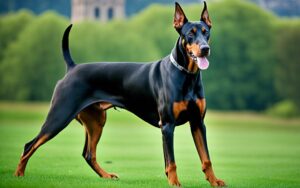
Did you know that approximately 25% of Dachshunds, especially those with short legs, are prone to spinal issues? These beloved dogs, known for their unique body shape, are more susceptible to conditions like intervertebral disc disease (IVDD) that can cause severe pain and spinal cord damage. As a Dachshund owner, it is crucial to understand the causes, symptoms, and treatments associated with spinal issues to ensure the well-being of your furry friend.
- Key Takeaways: Spinal Issues in Dachshunds
- What is Intervertebral Disc Disease (IVDD)?
- Symptoms of Spinal Issues in Dachshunds
- Diagnosis of Spinal Issues in Dachshunds
- Causes of Spinal Issues in Dachshunds
- Treatment Options for Spinal Issues in Dachshunds
- Prevention of Spinal Issues in Dachshunds
- Genetic Considerations for Spinal Issues in Dachshunds
- Research and Education on Spinal Issues in Dachshunds
- Conclusion: Spinal Issues in Dachshunds
Key Takeaways: Spinal Issues in Dachshunds
- Dachshunds, particularly those with short legs, are prone to spinal issues like intervertebral disc disease (IVDD).
- IVDD can cause severe pain and spinal cord damage in Dachshunds.
- Recognizing the symptoms of spinal issues in Dachshunds is essential for prompt veterinary care.
- Diagnosis of spinal issues involves physical exams and diagnostic imaging.
- Spinal issues in Dachshunds are primarily caused by abnormal disc structure and can be aggravated by factors such as obesity and trauma.
What is Intervertebral Disc Disease (IVDD)?
Intervertebral disc disease (IVDD) is a common condition that affects the spinal health of Dachshunds and other breeds. It occurs when the discs between the vertebrae in the spine bulge or burst, leading to compression and damage to the spinal cord.
This condition can cause various debilitating symptoms, including pain, nerve damage, paralysis, and loss of bladder and bowel control. IVDD is especially prevalent in Dachshunds due to their long spinal structure. It is often caused by a combination of genetic predisposition and age-related degeneration of the discs.
To better understand the impact of IVDD on Dachshunds, it is essential to dive deeper into the causes, symptoms, and preventive measures.
Symptoms of Spinal Issues in Dachshunds
The symptoms of spinal issues in Dachshunds can vary depending on the severity and location of the problem. It is important for Dachshund owners to be aware of these symptoms in order to recognize the signs and take prompt action for their pets’ well-being.
- Back Pain: Dachshunds experiencing spinal issues may exhibit signs of back pain, such as sensitivity to touch or reluctance to engage in activities that involve the back.
- Reluctance to Move or Jump: Due to the discomfort, Dachshunds with spinal issues may hesitate to move, run, or jump, showing a decreased level of physical activity.
- Difficulty Walking or Climbing Stairs: Spinal issues can impact a Dachshund’s mobility, leading to difficulties in walking or climbing stairs. They may appear unsteady or have trouble coordinating their movements.
- Changes in Posture: A noticeable change in posture, such as an arched back or a hunched posture, can indicate the presence of spinal issues in Dachshunds.
- Loss of Bladder or Bowel Control: In more severe cases, Dachshunds with spinal issues may experience a loss of bladder or bowel control, which requires immediate medical attention.
Recognizing these symptoms is crucial for ensuring early intervention and appropriate veterinary care. If you observe any of these signs in your Dachshund, it is recommended to consult with a veterinarian to determine the best course of action for managing dachshund back pain and addressing the underlying spinal issues.
“Understanding and recognizing the symptoms of spinal issues in Dachshunds is vital for their well-being. Prompt intervention and proper management can help alleviate pain and prevent further damage.”
Diagnosis of Spinal Issues in Dachshunds
To accurately diagnose spinal issues in Dachshunds, veterinarians utilize a comprehensive approach that includes physical examinations, review of medical history, and advanced diagnostic imaging techniques. These assessments allow the veterinarian to evaluate the condition of the discs and identify any abnormalities or damage. Along with a thorough evaluation, the veterinarian can determine the most appropriate treatment plan for each individual Dachshund.
During a physical examination, the veterinarian will carefully assess the Dachshund’s gait, motor function, and range of motion. They will also perform palpation, gently feeling along the spine to identify areas of tenderness or discomfort. An examination of the limbs and coordination may also be conducted to check for any signs of weakness or nerve abnormalities.
In addition to the physical examination, reviewing the Dachshund’s medical history is crucial in understanding the onset, duration, and progression of the spinal issues. Information regarding previous injuries, changes in behavior or mobility, and any familial predispositions can provide valuable insights into the underlying causes of the problem.
To further investigate the condition, veterinarians employ diagnostic imaging techniques such as x-rays, MRI scans, or CT scans. These imaging modalities provide detailed images of the spine, allowing for precise visualization of the discs, vertebrae, and surrounding structures. The images help identify herniated discs, degenerative changes, fractures, or tumors that may be contributing to the spinal issues.
“Accurate diagnosis of spinal issues in Dachshunds is crucial to develop an effective treatment plan and provide the necessary support for their mobility and well-being.”
By combining physical examinations, medical history review, and advanced diagnostic imaging, veterinarians can accurately diagnose the spinal issues in Dachshunds and determine the appropriate course of action. This comprehensive approach ensures that each Dachshund receives the necessary care and support tailored to their specific needs.
Causes of Spinal Issues in Dachshunds
The main cause of spinal issues in Dachshunds is the abnormal structure of their discs, which are more prone to degeneration and herniation. This abnormality is related to the genetic traits that give Dachshunds their short legs (chondrodystrophy). Dachshund disc disease is a common term used to describe the degeneration and herniation of the intervertebral discs in Dachshunds.
In addition to genetic factors, there are other contributing factors that can lead to spinal issues in Dachshunds. These include:
- Obesity: Excessive weight can put extra strain on the spine, leading to increased disc degeneration and potential herniation.
- Trauma: Accidents, falls, or rough play can injure the spine and discs, increasing the risk of spinal issues.
- Age-related degeneration: As Dachshunds age, their discs naturally degenerate, making them more susceptible to spinal issues.
By understanding the causes of spinal issues in Dachshunds, owners can take proactive steps to promote dachshund spinal health and reduce the likelihood of their Dachshunds developing disc disease.
| Causes of Spinal Issues in Dachshunds | |
|---|---|
| Genetic Factors | Abnormal structure of discs related to the short-legged trait in Dachshunds (chondrodystrophy) |
| Contributing Factors |
|
Treatment Options for Spinal Issues in Dachshunds
When it comes to treating spinal issues in Dachshunds, the approach will vary depending on the severity and nature of the problem. Here are some treatment options that veterinarians may consider:
1. Mild Cases:
For mild cases of spinal issues, conservative management may be recommended. This can include:
- Pain medication: Medications such as nonsteroidal anti-inflammatory drugs (NSAIDs) may be prescribed to help alleviate discomfort and reduce inflammation.
- Rest: Limiting physical activity and providing a comfortable and quiet space for the Dachshund to rest can aid in the healing process.
- Physical therapy: Stretches, exercises, and massage techniques can be utilized to improve muscle strength, flexibility, and overall mobility.
2. Severe Cases:
In more severe cases, surgery may be necessary to address the underlying issue:
- Discectomy: This surgical procedure involves removing the damaged intervertebral disc to relieve pressure on the spinal cord.
- Disc fenestration: In some cases, a minimally invasive procedure called disc fenestration may be performed. It involves creating small openings in the disc to release pressure and alleviate symptoms.
- Spinal fusion: For situations where multiple discs are affected, spinal fusion surgery may be recommended. This procedure aims to stabilize the spine by fusing the adjacent vertebrae together.
3. Rehabilitation and Mobility Support:
After surgery or as part of the overall treatment plan, rehabilitation and mobility support measures can help Dachshunds regain or maintain their mobility:
- Physical rehabilitation: Exercises, hydrotherapy, and other specialized techniques can aid in muscle recovery, improve range of motion, and strengthen the supporting structures around the spine.
- Assistive devices: Wheelchairs, carts, or specialized harnesses L’il Back Bracer for IVDD can provide support and aid in mobility for Dachshunds with spinal issues.
It is important to remember that every Dachshund is unique, and the treatment plan should be tailored to their specific needs. A veterinarian will assess the individual case, consider the potential benefits and risks of each treatment option, and collaborate with the pet owner to determine the most suitable course of action.

| Treatment Options | Description |
|---|---|
| Mild Cases | A combination of pain medication, rest, and physical therapy to manage symptoms and promote healing. |
| Severe Cases | Surgical intervention to remove or repair damaged discs, such as discectomy, disc fenestration, or spinal fusion. |
| Rehabilitation and Mobility Support | Physical rehabilitation and the use of assistive devices to aid in recovery and improve mobility. |
Prevention of Spinal Issues in Dachshunds
While it is not always possible to prevent spinal issues in Dachshunds, there are measures that can be taken to minimize the risk. By prioritizing proper care and maintenance, owners can help improve the spinal health of their beloved pets.
1. Maintain a Healthy Weight
Obesity can put additional strain on the spine, increasing the risk of spinal issues in Dachshunds. Providing a balanced diet and regular exercise is crucial for maintaining a healthy weight and reducing unnecessary pressure on the spine.
2. Provide Proper Nutrition
Feeding high-quality, nutrient-rich food plays a vital role in promoting overall health and supporting the spine’s well-being. Consult with a veterinarian to determine the best diet for your Dachshund’s specific needs.
3. Avoid Activities that Strain the Spine
Engaging in activities that involve excessive jumping, rough play, or sudden twists can strain the Dachshund’s spine and increase the risk of spinal issues. Encourage gentle exercise and provide them with a safe and supportive environment.
4. Regular Veterinary Check-ups
Keeping up with routine check-ups allows veterinarians to monitor the condition of your Dachshund’s discs and identify any early signs of spinal issues. Regular examinations serve as preventive measures, ensuring prompt intervention if necessary.
5. Responsible Breeding Practices
Breeders play a crucial role in minimizing the prevalence of spinal issues in Dachshunds. By avoiding the breeding of dogs with known genetic predispositions to spinal issues, breeders can help reduce the transmission of these conditions to future generations.
By following these preventive measures, Dachshund owners can significantly lower the risk of spinal issues and promote the long-term spinal health of their beloved pets.
Genetic Considerations for Spinal Issues in Dachshunds
Spinal issues, particularly intervertebral disc disease (IVDD), in Dachshunds have a strong genetic component. The condition is closely linked to the genes responsible for the short-legged trait in Dachshunds. While genetic testing is currently unavailable to identify susceptible individuals or predict the likelihood of affected puppies, breeding programs focused on selecting dogs with fewer calcified discs can help reduce the incidence of spinal issues.
However, complete elimination of the disease is unlikely without significant changes to the breed’s physical characteristics. To address this challenge, breeders and researchers are continuously working towards understanding the genetic factors influencing spinal health in Dachshunds and developing strategies to minimize the occurrence of disc diseases.
In the future, advancements in genetic science may lead to breakthroughs in identifying specific genes and markers associated with dachshund disc disease, enabling targeted breeding practices to reduce the prevalence of spinal issues. Additionally, ongoing research and collaborations between breeders, veterinarians, and geneticists aim to improve the overall well-being of Dachshunds and ensure their long-term spinal health.
| Genetic Considerations for Spinal Issues in Dachshunds | Implications |
|---|---|
| Genes related to short-legged trait | Strongly linked to the occurrence of spinal issues, particularly IVDD |
| Unavailable genetic testing | Unable to detect susceptible individuals or predict affected puppies |
| Breeding programs | Focus on selecting dogs with fewer calcified discs to reduce the incidence of spinal issues |
| Significant changes to the breed | Required for complete elimination of dachshund disc disease |
Research and Education on Spinal Issues in Dachshunds
Ongoing research and education initiatives play a crucial role in improving our understanding of spinal issues in Dachshunds and developing better prevention and treatment strategies. Leading organizations such as the Dachshund Club of America (DCA) and the American Kennel Club Canine Health Foundation are actively involved in funding studies focused on investigating various aspects related to dachshund spinal health, including gait recovery, muscle function, and more.
These research efforts aim to provide valuable insights into the causes, progression, and management of spinal issues in Dachshunds, ultimately contributing to their overall health and well-being. By advancing our knowledge and expertise in this area, we can enhance the quality of care provided to dachshunds and effectively address dachshund back problems.
Through the dissemination of research findings and educational resources, breeders, owners, and veterinarians can stay informed about the latest advancements in dachshund spinal health. This information enables them to make informed decisions about breeding practices, early intervention, and the implementation of preventative measures to support the long-term spinal health of these beloved canine companions.
As research continues to shed light on the complexities of spinal issues, ongoing education and collaboration are essential for promoting the well-being of Dachshunds and minimizing the impact of dachshund back problems. By working together, researchers, breeders, owners, and veterinarians can create a brighter future for Dachshunds, where spinal health is prioritized and dachshunds can live their lives to the fullest.
Organizations Contributing to Dachshund Spinal Health Research
| Organization | Description |
|---|---|
| Dachshund Club of America (DCA) | An organization dedicated to the preservation, promotion, and protection of the Dachshund breed. The DCA actively supports research on dachshund spinal health and sponsors studies to advance our knowledge in this field. |
| American Kennel Club Canine Health Foundation | The AKC Canine Health Foundation is committed to advancing the health of all dogs. As the largest funder of canine health research in the United States, the foundation provides vital funding for studies investigating various aspects of dachshund spinal health. |
Conclusion: Spinal Issues in Dachshunds
Spinal issues, particularly intervertebral disc disease (IVDD), are a common problem in Dachshunds. These adorable dogs, with their characteristic long spines, are more susceptible to disc degeneration and herniation. However, with proper management, prevention strategies, and ongoing research, Dachshunds can continue to lead happy and healthy lives.
Managing dachshund back pain is crucial for their overall well-being. By recognizing the symptoms of spinal issues, such as back pain and difficulty in movement, owners can seek timely veterinary care and implement appropriate treatment options. This may include pain medication, rest, physical therapy, and in severe cases, surgical intervention to repair or remove the damaged discs. Additionally, mobility support measures like wheelchairs or specialized harnesses can help Dachshunds maintain their mobility.
Prevention plays a vital role in reducing the incidence of spinal issues in Dachshunds. Maintaining a healthy weight, providing proper nutrition, and avoiding activities that strain the spine are essential. Regular veterinary check-ups, especially for older Dachshunds, allow for early detection and intervention. Furthermore, responsible breeding practices that focus on selecting dogs with fewer calcified discs can help decrease the genetic predisposition to spinal issues.
Ongoing research and education initiatives, led by organizations like the Dachshund Club of America and the American Kennel Club Canine Health Foundation, are dedicated to improving our understanding of spinal issues in Dachshunds. These efforts contribute to the development of better prevention and treatment strategies, ultimately enhancing the overall care and quality of life for these beloved dogs.














